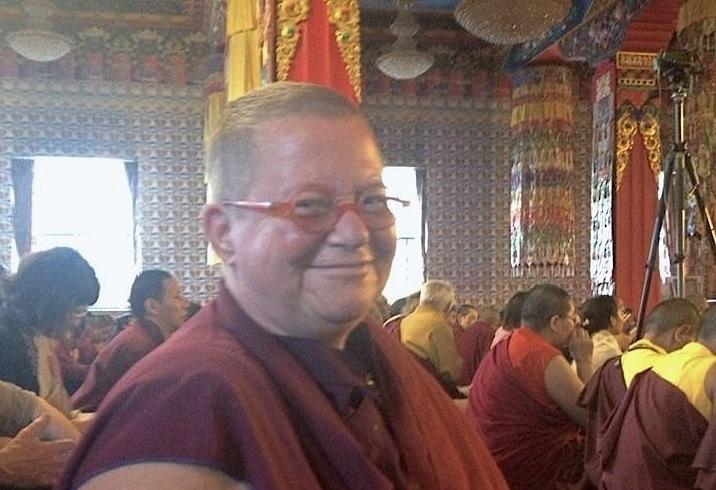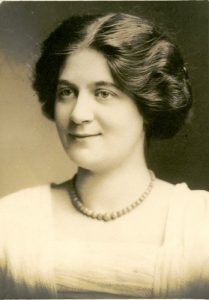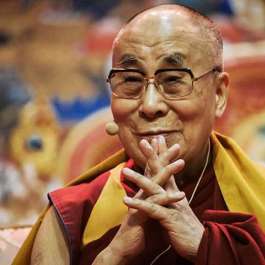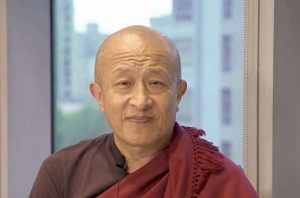
Earlier this year, Buddhistdoor published the life story of Ani Zamba Chozom in eight weekly parts.* One of the first Westerners to be ordained as a Buddhist nun, Ani Zamba currently lives in Brazil, where her practical teachings, rooted in the simplicity of Dzogchen, are proving an inspiration to Buddhists and non-Buddhists alike. Here, in three weekly parts, is a sample of Ani’s teachings, in the form of a conversation.
Frances McDonald: What is your approach to teaching?
Ani Zamba: I am always teaching how to look at things in different ways. You don’t have to maintain the psychological patterns that bring confusion and suffering in your life—you can look at things in different ways, and then you can have a positive outcome instead of a negative outcome. A positive outcome is something that brings you closer to your own nature and a negative one is something that takes you away. It’s not about morality or anything like that. A positive outcome would bring more clarity to the way you see things—less tendency to get lost in your projections. I think that always brings positive results.
FM: Could you clarify what you mean by “projections”?
AZ: As soon as you think of “other than self,” and you believe that other actually exists, that’s a projection. It means you’re constructing an objective world that is separate from the perceiver of that objective world. Whilst you still have the dualistic vision that there’s something here perceiving something there, that’s a mental projection. Like a projector and a screen—if you believe that those images can arise on the screen independently of the projector then you’re pretty naive, but that’s what we do with our mind now. We believe everything we perceive through the senses and how we interpret it through our mental consciousness—we believe it actually exists the way we think it does. We don’t question it. We don’t ask, “How is my mind constructing this experience, and why does this phenomenon appear this way to me at this moment? What conditions are necessary to make it appear that way?” Nothing happens just like that.
FM: That’s what makes us suffer.
AZ: If we understand how we construct all our experience—all the conditions that are necessary to construct a certain way of seeing things—then we can also understand how to deconstruct, and reconstruct in a different way. This brings more positive results in the sense that it brings you closer to the true nature of phenomena. And so when you see things more in line with their unconditioned nature, then fewer conditions for confusion and suffering arise in your life. You don’t interpret things in the confused, distorted way that you do now—you see things as they are and not how you think they are. When you see something as you think it is, if you believe in what you’re thinking at that moment, it becomes your reality. But if you know it is just your interpretation, that it depends on certain conditions to appear that way in this moment, then you don’t have such a fixed perception of the phenomenal world or people as being this way or that way.
FM: That’s why it’s said to be an illusion.
AZ: Yes. You understand that if you change a few conditions here and there, things will appear in a different way. Everything depends on conditions to appear to exist a certain way—it doesn’t really exist that way. We don’t understand the difference between appearing to exist and actually existing. If something truly exists, it shouldn’t depend on any conditions. It shouldn’t change. Everyone should see it the same way. How many of us can say that about anything? No, we all see things in different ways. So what does that mean? It means that something depends on certain conditions to appear in a particular way to the individual perceiving it. And when you take those conditions away, they can’t see it that way. It’s wonderful—good news!
FM: It seems very freeing.
AZ: We never investigate deeply enough to see how we’re constructing our experience because we believe that life is happening to us, not that we are generating our own experiences of whatever is taking place. We don’t understand how the mind works, so then we don’t put a value on understanding in what ways we’re imprisoned by our conditioning. Whether we understand what I’m saying or not, we can hear it by the way we communicate every day with the people around us. As soon as we say, “It’s like this, it’s like that, this person’s like this, this person’s like that,” what are we saying? It’s become your reality, that’s the way it is. Is it? Really? Why is it? I don’t see it that way. Are you saying I’m wrong? No, we just see in different ways because we have different conditioning.
FM: So we should look at what we’re doing.
AZ: When anything happens that we may not like, then we immediately have to ask, “What’s happening here? There’s a reason for not liking this. I must be reifying something so that it appears to me as having value from its own side, otherwise why would I not like it?” If I really saw its empty, non-fabricated nature, there’d be no reason to like or not like it—I could just rest. There’s some idea there that I believe in that triggers that feeling of liking or not liking something. There’s endless ways that you’re constantly challenging your practice, to be honest with yourself as to whether you’re actually seeing things clearly or not. You can see very quickly just by your reactions. That’s where the guru comes in, because the guru never gives you what you want. He gives you what you don’t want, and then you can see your reactions.
FM: A lot of people these days don’t have that access to a guru. Do you think that’s a problem?
AZ: I think that is a problem.
FM: What is the solution? In Tibetan Buddhism, Dzogchen, which are so popular now, the guru is important, but these days you’re given the teachings and then you’re left on your own.
AZ: I think it’s easy to deceive yourself—too easy. So I think we need a really good foundation to our practice. And in the beginning, it really means studying step by step what we consider an authentic path.
FM: A causal path?
AZ: Yes. You need to get a good grounding in all the basics. And then, you need not only to have an intellectual idea, you have to contemplate the teachings. I think in most of the practitioners I meet, the phase of contemplation is missing. They have a little bit of meditation and they have a lot of listening or study or whatever, but they don’t have the bridge in the middle, which is the contemplation.
FM: What should they contemplate?
AZ: The contemplation comes when you take these ideas and you bring them back to your daily life experience. “How does that work? How does that make sense in relation to what’s happening in my daily life? All these ups and downs, all these conflicts, whatever it is, how does it work?” When we talk about suffering, it’s not enough just to leave it as an intellectual idea. “What does it mean in relation to my life when I consider I’m going through some kind of suffering or frustration? What is it? How does it work?” Then it makes sense to you, otherwise it’s just another idea.
FM: A bit of analysis, then.
AZ: Yes, a bit of analysis. You have to bring these teachings back to your own personal experience otherwise they just remain in the head, they don’t come down to the heart. When they make sense to you, through your own personal experience of what’s going on in your life, then the meditation really puts a seal on it. You begin to see things first-hand and not from a third-hand perspective, through direct perception of how your own mental processes work. Through the repetition of observing again and again you begin to see more and more details, more and more conditions, how they’re all coming together in different ways. Your own experience ceases to be something solid. You see how it depends on changing conditions, and then you can work more and more with these changing conditions.
*The Life Story of Ani Zamba Chozom: Part One – Journey to India
The Life Story of Ani Zamba Chozom: Part Two – Meeting Lama Yeshe
The Life Story of Ani Zamba Chozom: Part Three – Ordination, First Retreat, and First Teaching
The Life Story of Ani Zamba Chozom: Part Four – Finding the Nyingma Lineage
The Life Story of Ani Zamba Chozom: Part Five – Dzogchen and Meeting Her Teachers
The Life Story of Ani Zamba Chozom: Part Six – Thailand, Burma, and Korea
The Life Story of Ani Zamba Chozom: Part Seven – From Korea to the Philippines to Hong Kong
The Life Story of Ani Zamba Chozom: Part Eight – Brazil











